In search of the most pristine nature that BC can provide, me (Ilya Capralov) and Martin Cermak have discovered a new touring style – Swimpacking. To reach lakes Hobiton and Tsusiat located on the West Coast of Vancouver Island, we tied drybags with food, clothes and camping gear to our backs and swum towards one of the largest and wettest old growths in BC. The hidden jewels of Vancouver Island remained unclaimed, but the lessons learned from the trip have powered further explorations of Swimpacking and may one day help us or someone else to finish our initial goal and add Lakes Tsusiat and Hobiton to the list of conquered peaks, bike trails and ski lines. In these fundamentals I have zealously collected and recorded our experience and lessons that we’ve learned throughout our swimpacking trips in hope that someone will find in swimpacking their new passion (and I won’t have to swim alone again).
***
Chapter 1: Genesis
Martin Cermak is environmental fundamentalist. When we got into open water swimming he was in a search for a body of water that would be surrounded by the old growth that was never touched by human. I think the idea might have come to him from my story of me and Lukas Schreiber swimming around campus last year. That time we started the swim from Wreck Beach and ended at the Tower Beach. We were astonished by the views we got on the thin wall of old growth that surrounds the campus and the emotions that overwhelmed us during that swim. The smooth and anesthetizing feeling of water around you, the communication with playful and curious seals who were following us through their territory, the birds skimming the surface of the water… But despite our feelings all that was fake, just a theatrical decoration if you think about it. It only takes to turn around the corner and you can see the skyscrapers of Vancouver Downtown; the old growth is only a couple-hundred meters thick wall. Martin would not be satisfied with just a theatrical experience, he looked for deeper experiences. So, we pushed it further.
The first trip that me and Martin did in the search of pristine waters was Salmon Inlet north of Sechelt on Sunshine Coast. That time we bikepacked almost all the way to the water but were stopped by a completely overgrown road bellow the powerline. We left our bikes and pushed through the bush by foot all the way to the water. Despite all the efforts Salmon Inlet didn’t look pristine enough: the forest around us was young second growth and once we broke through to the water, the first thing that we saw was a salmon farm. Especially after watching a documentary about environmental harm that these farms are causing, the experience from that place considerably deflated. We still did 2 km of swimming, constantly giggling from the fact that we bushwacked for 2 hrs to just swim in the sea.
“Pushing through the bush for 2 hours just to take a dip in the water, haha”
“Don’t forget that we will also have to go back through the bush…”
One of the most interesting things that I observed on this swim was the constant dynamics of water. When you are swimming in the swimming pool you know every response of the water after every move that you do. No waves, no changes of the water properties throughout the pool. When you’re in open water, and especially in the ocean, things are constantly changing. The first thing that surprized me was constant and rapid changes of water salinity throughout the swim. We were swimming close to the shore and because of that we could taste that water from the in-flowing creeks which were bringing fresh water into the see. With the salinity other water properties changed – color, turbidity, temperature and even smell of the water. Close to the creek water was turning softer (less salty), murkier and took brownish color. At one of the creeks water reached saturated milky red color and we couldn’t see our hands. All this was probably dissolved soil, thus it smelled like soil.
We also got some valuable lessons from the trip: we learned that swimming in choppy waters is a bit harder, wet suits can chafe your neck and sitting on the shore in your wetsuit doesn’t make you warmer. Also GPS doesn’t work under water.
That trip confirmed our desire to go for a truly wild experience. One night, while surfing through satellite images of Vancouver Island I have stumbled upon three lakes on west shore of the Island. They are long in shape and two of them almost reach the ocean, while the third is separated by 500 and 1000m from other two lakes, making a triangle if you trace a line parallel to each lake. These lakes are surrounded by dense, green forest that is apparently darker then the rest of the forest on the island. After checking with Parks Canada database, it turned out that these lakes are part of Pacific Rim Park, the one where famous West Coast trail is located. The park mostly follows the west coast of Vancouver Island from Port Renfrew to Bamfield, forming a thin wall of pristine nature guarding the shore. The only brave indent that the park makes inland is where Lakes Nitinat, Hobiton and Tsutsiat form so called “Nitinat Triangle”.
I have sent my find to Martin (even before the Salmon Inlet trip) and in a few weeks we have developed enough interest to start doing in-depth research of this place. We found out that the only 2 ways to get to the untouched forest deep in the park was to cross Nitinat Lake and hike to Hobbiton Lake, after which we could swim surrounded by true old growth. The other way was to hike the West Coast Trail following the Pacific shore and then bushwack to Tsusiat Lake. But neither of these options provided the ability to swim in both lakes because the lakes are too large and there are no trails that would lead from Lake Nitinat all the way to Pacific Shore. There was also an option of taking a canoe up to lake Hobiton, then portage it to Tsusiat and then to Lake Nitinat. Later I found that what I have described is a canoeing route called “Nitinat Triangle“. It is notorious for being one of the hardest kayaking routes in BC, mostly, thanks to portages via overgrown trails that make most of the groups to turn around. Ones who persist, spend up to 6 hours on 1-km-long portage, and there is 3 of them. The trails of Nitinat Triangle wasn’t maintained for decades, so canoe had to be dragged across fallen trees, squeezed through the bushes and balanced on the sides of slippery cliffs. On average it takes experienced canoers 4-6 days to finish the route.
Me and Martin never canoed, so canoeing didn’t seem like an option; there was no trails along the lakes, so moving camping gear and food across the lakes was still a problem. Then I came up with another idea: Why not putting all the gear and food in a dry bag and towing it on a rope behind us while swimming? I spent a few hours on English and Russian internets trying to search for anyone doing something similar, but I haven’t found anyone towing more then their clothes and shoes in a dry bag. Frankly, this circumstance gave me more enthusiasm, “Are we the first ones doing this?” Obviously, what is more likely is that my internet searching skills suck…
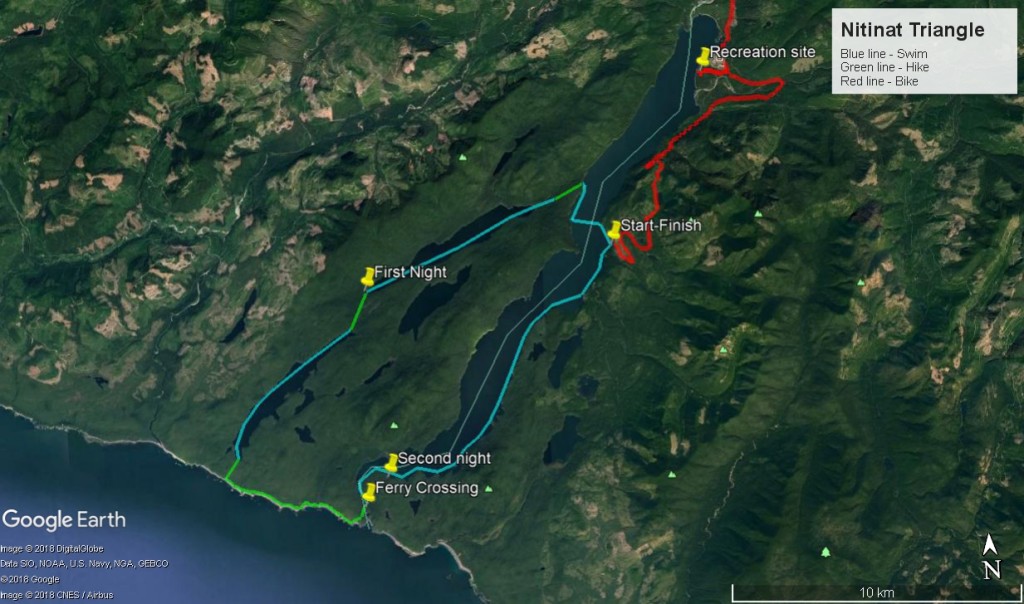
We have settled on the route displayed above and started working on planning. Despite our hunt for wilderness and nature, we had to battle against a bit of bureaucracy with Parks Canada before we were able to get into the park. I read on Parks Canada website that Pacific Rim Park has an extraordinary 127.50$/pers fee just for the entrance and plus 7.80$/pers per day. Since we were not doing the trail and would only use 7 km of 50 km of the trail I called to Nitinat to ask if the payment can be waved for poor students (us). Before asking my inquiry I shortly explained what plan we had in mind and why we didn’t want to pay the fee for the trail. By phone, I simply described our route that we were planning to swim.
It predicted a total of 28 km of swimming, 3 hiking/bushwhacking sections, 2-3 nights and 3-4 days. After this description the officer stopped me without even letting me to start talking about the main enquiry.
- “I’m sorry but I’m sure you will not be allowed to do that. I’m afraid we will not be able to sell you the passes for the access”.
Even after 4 years in Canada I can’t get used to someone not allowing me to risk my own life and health (weird). On the other hand, they have to deal with tens of rescues per season, withdrawing inexperienced and ill-prepared hikers from the trail, so their conservative response is understandable.
Officer was familiar with this route because it is a known canoeing route that is done about 10 times a year, but she never heard anyone doing this by swimming and is certain that no one has attempted it before.
“Our safety team will certainly not be okay with your plans”
To convince them to let us do the trip I have spent 2 weeks emailing and calling back and forth with Nitinat safety team coordinator, and other Parks officials; sending reports, GPS tracks and videos from our training sessions in open water. In the end of this bureaucratic process me and Martin were allowed to buy the pass and, no we didn’t get a single dime off the full price which ended up being 160$ per person only for the passes.
As I mentioned, before attempting Nitinat Triangle me and Martin rehearsed one day of our Nitinat trip. Nitinat Triangle entails 2-3 nights and 3-4 days of swimming. Sleeping and eating utilities are suddenly added to the equation that have to be somehow transported. Idea was to put everything in a drybag, tie it to the waste and drag it behind, assuming it would be buoyant, the drybag would not leak, it wouldn’t cause too much drag on us to slow us down to halt, and we would still be able to swim 8-10 km per day. This was a lot of “ifs” so we had to test this set up before attempting Nitinat. Our choice of location for our rehearsal was Butzen lake. It has one of the coldest waters in Vancouver, so we could also test out our cold temperature tolerance that could be very handy in Nitinat and often is a problem for open water swimmers.
One weekend we have packed everything that we would bring to Nitinat in drybags, tied it to waste and jumped into the cold waters of Butzen Lake. The plan was to swim around the lake once and if we felt particularly motivated, go for a second lap. One lap gave us 7 km of distance. I have to confess that even then I was realizing that rehearsal conditions were a bit idealized, I didn’t bring as much stuff as I planned to bring to Nitinat, still waters of Butzen were not resembling choppy waters of Lakes in Nitinat Triangle where waves were accelerated by constant winds driven by strong solar effect that I knew will be present in Nitinat.
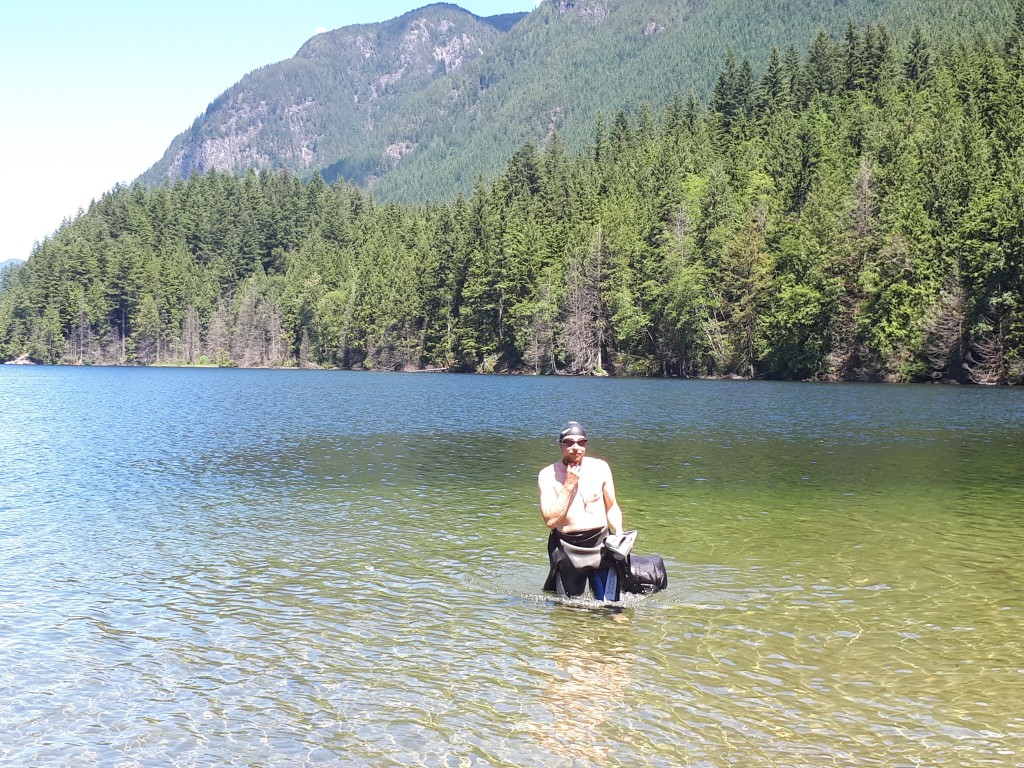
Martin gets out of the water on the northern tip of Buntzen Lake. You can see the floating bag dragging behind him.
Overall, rehearsal went well: Martin, with help of short fins, was keeping up with my pace, the bags were very buoyant and could even support the weight of the swimmer if needed. They were dangling nicely over our backs without interfering with kicking or stroking. From the lessons we’ve learned: waters were a bit chilly to my taste in 3 mm wetsuit – I would use a thicker wetsuit next time; Martin got his neck chafed. He tried to fix it with questionable method by making a collar out of duck-tape where the suit was chaffing his neck. As the result, his skin got even more chaffed from the edges of the tape. We were going to equip with “body glide” for Nitinat to prevent this situation.
We ended up doing a lap and a bit totaling 8.5 km. We stopped a few times on the way to refuel and drink. My initial idea of stopping every 20 minutes and resting for 10 minutes seemed absurd once we started swimming. Getting on the shore is faffy and much colder then we expected. Evaporating water chills you down much quicker then the water that slowly seeps into your suit while you’re in the water. It was much easier to just backstroke or simply chill on our bags for a bit to rest.
***
Chapter 2: Nitinat Adventure
This was logistically the most difficult trip I have ever organized. I have spent many nights calculating average speeds, distances, researching maps… Not that it gave a brilliant result, or I was able to predict how the trip was going to ends, it mostly speaks about my planning ability rather then anything else. One of the most concerning problems we had to address on this trip was to decide how much food to take. Not me, nor Martin ever been on such high output trips before. We had no idea how much we would need to eat and if we were even physically able to eat the amount we needed. I think that what I ended up taking certainly didn’t seem like it was edible in the time that we assigned for the trip even if we were to spend the entire trip just hanging in the hammocks and eating the food we brought. It was about 6 kg of pure low-water-content hydrocarbons fats and proteins. Bread (3,5 loafs), butter (2 sticks), peanut butter (jar), jam (jar), meat (0.6 g), sugar, powdered Gatorade. We thought that on this trip we could not afford to carry stove, so we mostly took ingredients for sandwiches. I didn’t eat sandwiches for a month after that trip. Don’t do this to yourself, folks, bring stoves on multiday trips, it is sometimes the key to keep the morale of the team high.
We have allocated 6 days to finish this trip including one flex day on NItinat triangle and 2 days on getting to and from Nitinat by bike. Swim packing trip was combined with backpacking route which in my opinion on it’s own is an interesting ride.
Aside from standard active logging roads it includes an interesting decommissioned road that still is listed on Google Maps as a passable road but in reality, is a pretty overgrown logging road with a destroyed bridge over a creek.
We headed out to Nanaimo Wednesday after work to start 100 km long ride in the early morning. The night at Nanaimo residential park was one of the worst nights I ever had in the outdoors. Since we thought there will be no place to set up a tent in Pacific Rim Park due to no camping infrastructure there, we opted for hammocking on this trip. Unfortunately, we didn’t think how wild can mosquitoes get in BC. At some point during the night it was getting so bad that despite surrendering my face to mosquitoes it was still impossible to sleep because they were getting into my nose and making me sneeze and cough all night long. A few hours before the wake-up time I have figured out the way to breathe into the fabric of hammock through which they were still able to bite my already completely obliterated face but at least they weren’t getting into my nose and mouth.
A few words about the hammock modification you see in the image above. The shiny silvery thing underneath the hammock is an emergency blanket attached to the hammock using cords and gorilla tape. It forms a layer of dead air between the back of the sleeper and the outside air, impeding convectional heat transfer. The blanket also traps the infrared radiation from the body. All these factors add ~5 degrease to the comfort for just 50 grams of additional weight. You can find the instructions for assembly of this underquilt here (I might add English version later).
When we arrived at Nitinat it looked like everyone in the town already knew who we are and what we are up to. While I was fighting the burrocratic battle the rumours of two “cycling swimmers” that are coming to swim 28 km has spread around the town.
In order to get our passes, we hade to get educated first and the park rangers had to get their money. On a small lecture we were told that it is prohibited to step outside of the path and to poop outside of the outhouses. Both rules are not applicable if you’re doing Nitinat Triangle because there are no trails or outhouses there. By the way, camping in Nitinat town is not free and you can’t sleep outside of it. I learned this when I innocently asked the park ranger: “Aren’t we allowed to sleep on the Crown Land?”. It wasn’t Crown Land (duh…). She was First Nation by the way… I had trouble falling asleep that night…
(On the way out of Nitinat we found a disgusting garbage dump)
During pre-trip faff me and Martin were debating whether we should to take tarps for the hammocks. The forecast was only 1mm for only one day. That meant that if we wouldn’t take tarps we could take more peanut butter and Gatorade powder with us. We decided to act conservatively and take tarps. When I woke up in the morning of the first swimming day I heard droplets of rain falling on my tarp. “There is the promised 1 mm of rain. Neat!” – I thought. We were starting swimming 18 km away from the place where we stayed overnignt. As we were covering that distance it was becoming clear that a nice pre-swim heat up turns into a cool down for our weak bodies and brittle minds as forecasted 1mm was rapidly overflowing into 5 and then in 10 mm. When we arrived at the lake we were as wet as if we came out of it. My phone battery thermometer reported 15 degrees. At that point we had to hold on and decide if we want to struggle through this wetness and temperature for potentially 3-4 days because it was clear that this rain was here to stay. It took our frozen brains 20 minutes to fight our ambitions and conclude that the mission is failed.
Retrospectively I am glad that we didn’t go for it because, as it was proven later, we were not ready for this trip not physically, nor technically. We have spent the rest of the day doing some extreme and shameful forms of relaxation in the hammocks, listening to rain and flying humming birds, eating through buckets of peanut butter and Nutella, sleeping and chatting. Despite all the comfort that was provided by the tent I cam up with a rather pessimistic human-nature relationship paradigm that I developed in this blog.
So far, we’ve learned only one thing from the trip – don’t rely on forecast if you go to Vancouver Island. Next morning I thought that we have to take at least something useful from $150 that we have payed to Parks Canada. I have convinced Martin to go for a rehearsal of one day of swimpacking. The plan was to take down our camp and swim with it somewhere down the stream of the lake till the next fresh water source and to set up the camp there for another night.
After hours of faffing we finally were ready to go. The most upsetting thing about swimpacking for me is the time it takes to put everything in the drybag. You need to put everything inside, including things that you normally would keep in your pockets and I often forget to do that or I lock the bag only to unlock it again to take out my ear plugs that I forget to put in my ears every time.
Once in the water we were up to another surprize: the word “Lake” in “Nitinat Lake” is only a formality, because in fact it is an inlet, just slightly above the sea level (4 m), filled with sea water with every tidal wave. Water seemed even saltier and more abrasive then in the ocean. Well, good that we don’t have to swim 12 km in this as we would have to if we decided to go for the full tour.
We spent another 20 minutes trying to fit the bags so that they don’t interfere with our swimming. It didn’t really work out because the bags we were practicing with on Butzen Lake were much smaller and weighted much less. I was tying my bag with backpack straps so that the bag would float over my back. The problem was that since it was much heavier then my previous bag, it would sink deeper, settle on my back and slide over to the side causing a huge interruption in my stroke. Martin had similar problem, so our speed decreased to barely moving. Soon started cooling down because we couldn’t move much to produce heat. We swum on anyway.
One of the best ways to swim in a straight line on the open water is to choose a visible waypoint on your way and just swim towards it until switching to a different waypoint. Our first waypoint was a small rocky island about 500 m away from us.
Despite multiple training sessions in the open water I still feel a bit uncomfortable in the water. While swimming I’m always trying not to look much in to the void of water not to see something that would scare me and cause me to panic. This time I was already on the edge, ready to jump out of the water any moment, so I was swimming with my eyes almost closed. I was feeling like a child watching a horror movie through their fingers, ready to shut close them when a monster shows up on the screen.
About 200 m into the swim I suddenly saw sandy bottom of the see mere half a meter from me. I totally lost my shit at this point and started panicking, making lots of splashes and gasping for air. “This is how people drown” – I thought and tried to get my shit back together. By this time Martin notices that I’m not alright, although I thing he was going through similar experience, so didn’t bother too much with me. I tried to ley on the water as flat at possible not to touch the bottom: “god knows what will happen if I touch this. I looked down into the water again and saw waves of yellow sand again under me. The sand was so close to me that I could easily touch it with my hand, and “oh crap, I just did it” but instead of feeling anything, my hand simply disappeared under the wavy surface of the sand. At that point my brain almost tripped out, but I started to understand what was going on. The “sand” that I was so scared of was a layer of muddy and salty water bellow the fresh water layer in which we were swimming. Although this realization didn’t make this situation even trippier, I could continue swimming, and this time I was trying to admire the weird phenomenon. It looked very much like the views you get from the window of the plane when it flies close to the clouds, but in that case, we were swimming over the clouds. When my hand was going over it, the current from my stroke was disturbing this silent surface throwing it into spinning swirls behind me.
The clouds of murky water have disappeared and water got saltier – we were inside of one of these clouds. Half way to the small island we saw the first jelly fish, then second and soon we got surrounded by dozens of them. Me and Martin were both born in landlocked countries, so we didn’t know if these jellies were harmless or not. As the density of them was increasing, our nerves were tensioning, and we were swimming closer and closer to each other until I felt a kick into my hip and I lost my shit again. I took a few more gulps of sea water, Martin didn’t look so confident either – He also felt a kick, but in his foot. Slowly going around each jelly fish we finally got onto the island which was all covered with star fish underwater. We got onto the shore slowly stepping on the slimy rock, trying not to step on (god knows if poisonous) starfish. It turned out later that those jellies were Moon Jellies – a completely harmless species to human.
It was a total defeat! We were going on a trip to make 28 km in 4 days, and now we are trapped on an island, surrounded by jellyfish and totally terrified by them, unwilling to step into the water again. The island was small, the presence of fresh water on the island was unlikely, so it was obvious that we would have to get back into the water sooner or later. We were getting very cold on fresh breeze, so our return into the water approached rather quickly.
Surprisingly, after we have passed the island we haven’t seen many jellies, nor the spooky false sea bottoms. We did about 500 m more when Martin reported that he was getting cold, so we started to look for the creeks to set up our new camp near it. It is surprisingly simple taste in salty water, because you can taste the change in saltiness of the water when you’re approaching a creek, so it took us just 5 min to find next creek. Luckily there is no shortage of fresh water in Nitinat Lake area.
Martin was already falling into cold melancholy so he didn’t seem to be to excited about what was happening. Once we got onto the shore we were able to get a bit warmer and go search for places for our hammocks. At that creek we were surrounded by huge old growth trees and it was surprisingly hard to find a place to put our hammocks. After an a long bushwacking session though the dense jungles of old growth we couldn’t find a single spot where we could put 2 hammocks. The trees were either too far apart, or too wide for our chord or the terrain wouldn’t allow us to tie the rope.
After giving up setting up the camp in the forest, we set it up on the shore and instead went for a long bushwacking walk in the forest because the main reason why we came in the first place was to look at one of the largest old growth in BC.
We got tired from the bushwacking fast and spent the rest of the day fighting boredom by eating through our immense food storages and singing Russian songs.
The next day we swum back to the start of the rehearsal. This time we were much faster and braver. On the way back I fully appreciated the swimming over the underwater clouds – quite a trippy experience. Later that day we managed to reach the midpoint between Nitiant and Nanaimo, but our route was laying to Victoria and then further to Swartz bay. We decided to compensate our failure in water by cycling 200 km in 1.5 days. It was very tiring but worth it.
As I said before, I’m thankful to the weather not allowing us go for the full distance. Main concern of Martin was that we will all get wet and will not be able to get dry and warm in 4 days, which, I agree, would by worthless torcher. According to my future experiences his prophecy would come true, not because of the weather as Martin predicted, but because the bag system that we used was extremely leaky. And this is only one problem that I know would happen, how many of them would we face on the trip? Kilometers of bushwacking through one of the densest forests in the world, navigation in the jungles with no trails, wild animals… I will probably need another year and a few more swimpacking trips before I will be ready to reattempt Nitinat Triangle. I’m sure I will one day – the route is too beautiful and athletically attractive to miss it.
***
Chapter 3: Indian Arm – Butzen Lake Loop.
For my next attempt I decided to go for a smaller bite, that I hopefully would be able to chew. The idea was to first bike to Indian Arm near Sasamat Lake, swim 4 km with a drybag to abandoned Powerhouse I and stay there overnight in a hammock. I didn’t know while planning that I would find a secret path behind the powerhouse and would take it to Butzen Lake. There I’ve arranged to meet with my friend Egor Peshkov to swim across Butzen Lake together (3 km). Ideally, I would finish off the loop and get back to my bike on Indian Arm, but Egor would persuade me to give me a ride on his car.
One of the first challenges that I faced was explaining all this to the owner of the cabin camp on Indian Arm. He couldn’t understand for a long time that I was not going to swim on his private beach, but just passing through: “how are you going to come back?”, “Tomorrow!?”, “You’re gonna drown!”
Remembering our past unfortunate experience with bag towing, I have modified the towing system. This time I tied drybag to my ankles. Here is how I did it: I first clipped a nylon webbing loop with a crocodile through a plastic loop already present on most of dry bags. Then I tied two ends of a 4 m rope to my ankles and clipped it though the nylon strap. This way the bag is positioned far enough behind me not to touch or interfere with my stroke as it did when it was tied to my shoulders. Since the rope that is tied to the legs can freely slide where it attaches to the bag, it also allows for a good kick while swimming. (Remember that optimal kick in long distance swimming is whatever allows your legs not to sink.) This setup provides plenty of leg mobility for this purpose. A crocodile clip allows for quick bag release if needed.
The water throughout the swim in Indian Arm was very calm, I was swimming with the tidal current which probably made the swim a lot easier. On the other hand, what didn’t make the swim easy at all was Giant Main Jellyfish. I don’t even have to use any superlatives to describe it because these creatures have a self-explanatory name. In contrast to Moon Jelly we encountered in Nitinat, this beast is 5 times larger. In summer months it is normally bloody red in color. The top view of it’s dome looks like an octagonal star, from the side it looks like someone flipped a frying pan with spaghetti in red tomato sauce. It’s sting is seriously venomous, painful and extensive due to size of the jelly. If stumbled into one I would lose my shit again and probably would drown. I saw maybe 20 of these, luckily most of them, especially the bigger once were 4-5 m deep in the water. Although sometimes I had to go around smaller and bigger ones. My neck was sore by the end of the swim because I had to constantly look forward inspecting the waters for hints of bloody red colors ahead of me.
It took me only 2 hours to reach the old building of Powerhouse with a single short stop on Twin Islands. You may remember, if you ever kayaked up there, the beach at the old Powerhouse is very small and is often used by arriving people as а toilet, so I didn’t want to stay long at that beach, even though the original plan was to camp there. So, I decided to try and go behind the powerhouse to find a better spot for camping away from the foul smells and noisy boaters that were docking every 30 minutes.
But before I went off into my small reconnaissance I hanged my sleeping bag and hammock on the branches as they turned out to be soaked in salty water leaking through the rolled top opening of the dry bag. I would have to fix this problem next time. I would be very disappointed if I discovered this drybag flaw on my Nitinat trip…
After an hour tumbling and roaming behind the powerhouse, I found a rather suboptimal route to a hidden trail that turned out to have quite a mystical vibe. It was likely built for the personnel of the powerhouse and it still in minor use today. It features multiple tall staircases with many broken stares, all overgrown with moss. It is very steep and is mostly carved out in the rock, making it quite exposed, though wide enough to enjoy the views and feel safe at the same time. (There is trad multipitch climbing route behind the powerhouse btw.)
I have hung my hammock right above the powerhouse, on the trail. I was getting water from the leaking turbines bellow the powerhouse. That water comes from Butzen Lake, I have no idea if it is safe to drink, but I did anyway…
Next morning, I was meeting with Egor to cross Butzen Lake. I packed my camp back in my drybag and assembled a backpack out of it using 2 volie-straps and backpack straps. Not the most comfortable hiking setup, but ok for a short portage. The hike to Butzen Lake included the entire newly discovered trail, that allowed me to fully appreciate its beauty and mysteriousness.
That day Egor was swimming for the first time in 2 years after he finished his competitive swimming career and for the first time in his wetsuit that he bought for sailing. It didn’t take long for his arms to get tired because the suit was stretchy as a car tyre (not stretchy at all). He took it off for a while before taking it back on because he got too cold, all while being in water.
Egor is a much better swimmer then me, but when he offered to tow my bag I lost him behind me very quickly. According to my estimates, the bag slows you down on 0.2 km/hr assuming your normal swimming speed is 2.5 – 2.7 km/hr.
For me, those 3 km in Buntzen Lake were much easier and more pleasant then 4 km from the day before. Fresh water is much easier to swim in: no waves, no currents, no jellies, no crazy boaters, the water is a bit warmer in summer and much cleaner.
After we finished the swim, Egor persuaded me to go to my bike on his car, so I technically didn’t finish the loop because I skipped the second hiking part. I will leave it for the next time. I am sure I will do Buntzen Loop many more times because it is a lovely route that is good for weekend training and can easily be done in two or even one day.
Indian Arm – Butzen Loop was the first successful swimpacking trip, so I have declared swimpacking as “a thing”
***
Chapter 4: Pushing deeper in Indian Arm
My next goal was to increase the length of the swim and I ended up overshooting a bit again. My next objective was to swim to Granite Falls on Indian Arm from the northmost road you can take on East shore of the inlet. It made for seemingly comfortable 8 km swim to the campground and then 8 km the next day to get back on the same route. A bit boring, but I jut wanted to probe my limits. For this trip I wanted to attempt to gather a teem of swimmers on VOC agenda, but ended up only gathering attention. I’m glad that Lucy Buchanan-Parker suggested to at least get a kayaker for the trip if I go alone to shield me from the boaters and to assist me in case I need help. I was very skeptical in the beginning of being able to find a kayaker for such a boring trip, but my friend Dmitry kindly agreed to help me out, which I’m infinitely thankful for, because otherwise the trip would have ended up not as happily as it did.
Dmitry followed me on a 2-person kayak, which was handy because I could hop on it at any point if I felt tired. With it, I didn’t even have to bike all the way to the north, instead we loaded the kayak at Belkarra and paddled to Buntzen Bay, where Powerhouse 2 is located. There I chanced into my wetsuit, tied my bag and swum on. Dmitry followed me on his kayak.
While paddling we saw lots of Big Mane Jellies passing under our kayak, so I was getting a bit nervous. Nevertheless, when I started swimming I saw a few jellies in the first few hundred meters and then they’ve disappeared for the rest of the swim. It looks like they prefer being in packs that are a few km in diameter.
The water is a bit choppier towards the northern tip of the inlet and towards the middle of the day, as well as more boats which caused most of the waves on the water. At one point I understood why some of the open water swimmers report sea sickness during the swim.
I never swum with a support vessel, nor did Dmitry paddle with swimmers, so we had to figure out communication, our relative positions to each other and cooperative navigation. I would call Dmitry by raising one hand and get some rest or drink from the bottle that I kept on the boat. We agreed that Dmitry would keep his kayak about 5 m away from me keeping me between the shore and the kayak. Swimmers have surprisingly narrow angle of vision, so I preferred when he was paddling a bit behind me, but that the kayak would still overlap with my body. That way I was able to see Dmitry and see when he was trying to communicate.
I must admit that Dmitry looked a bit bored (even though he didn’t take a single photo during the swim ☹). His main job was slowing down his kayak pushed by wind faster then I could swim.
I started feeling fatigued when I could already see the campground. For some reason once I’m locked on the finish line it doesn’t seem to be approaching for a long time. This causes me to become nervous and anxious, it makes my progress even slower and I become tired much quicker.
Once at the campground, I dried out, took my puffy to feel warm after spending 4 hrs in water, and decided that it would be awesome to do some stretching. Once I dropped down on my knees, I felt irony smell and felt something dripped down from my nose. I haven’t had bloody nose in years. I decided to stop the blood by sitting in my hammock with a tissue in my nose.
I woke up after 2 hours with a bloody tissue laying on my belly. I felt somewhat fresh but extremely hungry. I ate 6 or 7 wraps with spiced rice, sour cream, cheese, beans and chicken meet. It was one of the most delicious meals I ever had, and I think the trick was not in the food but in swimming. This mode of touring is extremely energy consuming. Every time I came back from a swimpacking trip I would loose 2 kilos of weight (possibly due to dehydration rather then starvation), sleep in day time (I normally don’t do this) and eat like it’s not my stomach I’m eating in (I think I’ll get it ripped one day after a swimpacking trip).
Soon I went back to my hammock and slept for 10 hours till 6 am. We decided to get on the water early in the morning to catch a bit of tidal current and avoid strong wind. But when I woke up, I felt that my left shoulder joint felt a bit weird and I decided not to push my self to avoid possible trauma. I read that many swimmers push themselves one time to forget about swimming for many months. If Dmitry wouldn’t have been there I would have to swim back and would possibly seriously damage my shoulder. It took us only 2.5 hours to get back to Belcarra. I recovered my shoulder in a few days and was swimming again.
***
Outro
This is only the beginning of my exploration of swimpacking. In my opinion, this touring methode is very promising: it allows for the routes that were previously impossible or not interesting to take. If extended the range of swimming a bit more then I have now, lots of new lakes, rivers and inlets open for exploration. Swimpacking is especially convenient for round trips which I am a huge fan of: you don’t have to trace you steps back to your kayak or canoe after hiking on the shore. Instead, you just drop into the neighbouring fjord or lake and continue exploration. I am usually not very sentimental but even I have to point out that swimming opens a new dimension in exploration of the environment you are in while traveling. You feel it’s temperature, see it’s depth, you interact with wildlife. It is very demanding but at the same time a very independent and rewarding mode of touring. I’m definitely sticking by swimpacking until I find some other, even more independent and exciting mode of touring (or until I blow my shoulders). My next big objective is Nitinat Triangle. I will likely do it either this fall or more likely some time next summer. By then, I will try to find more people interested in Swimpacking to join me on many more trips, including Nitinat. So welcome to swimpacking!

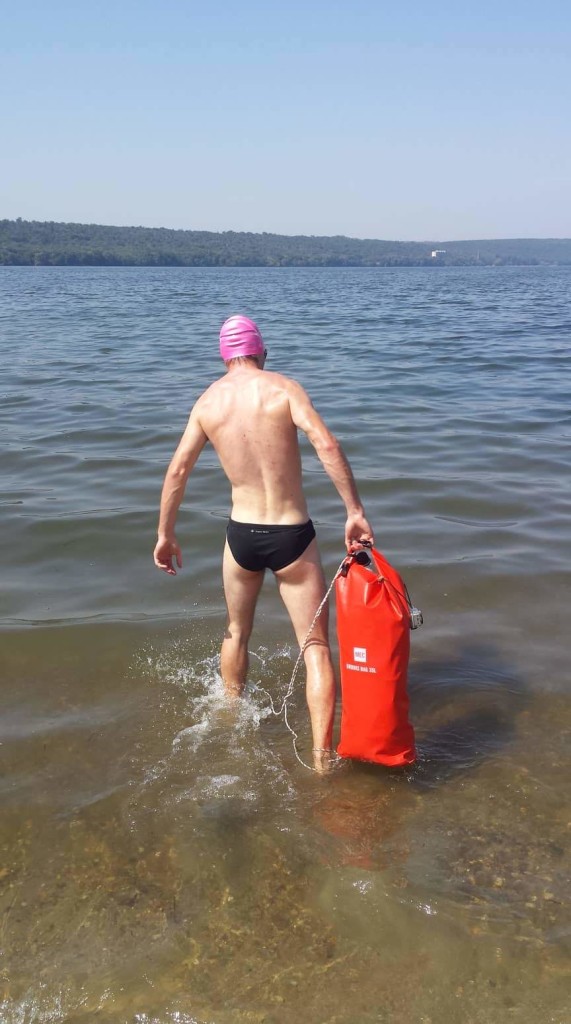
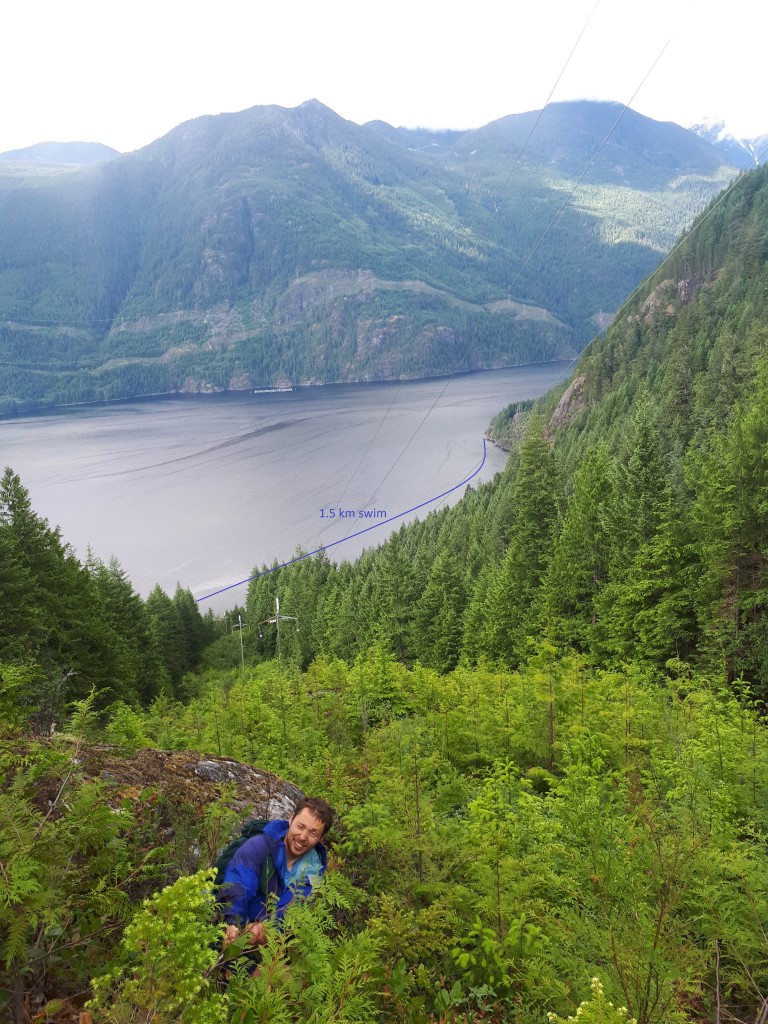

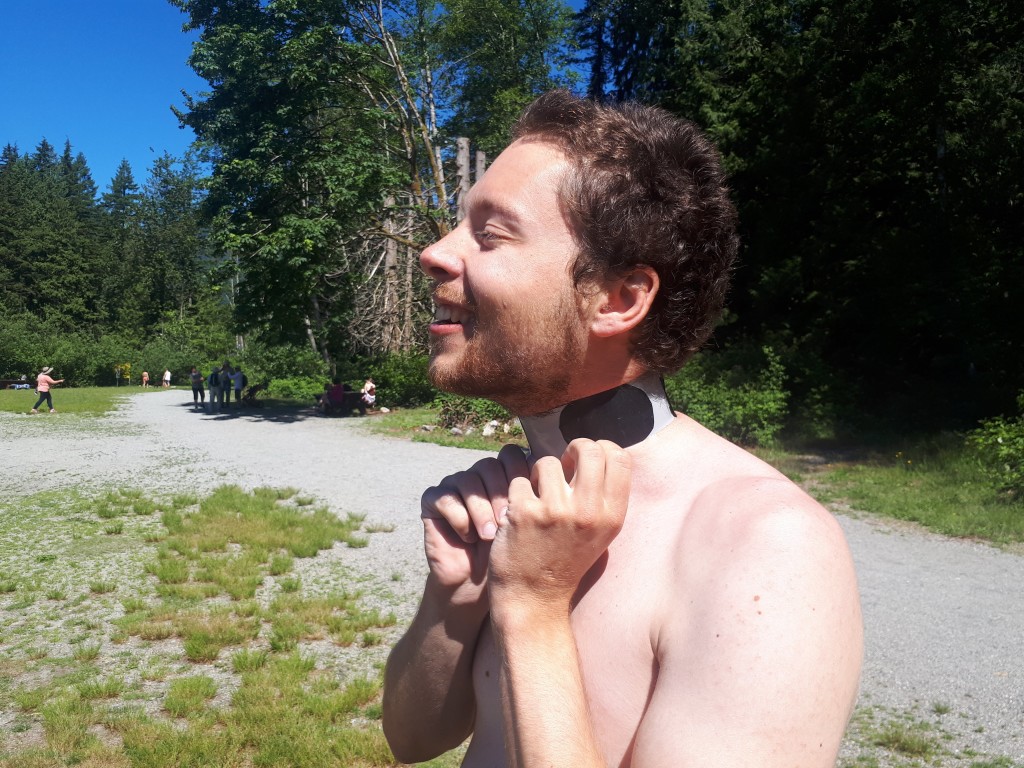
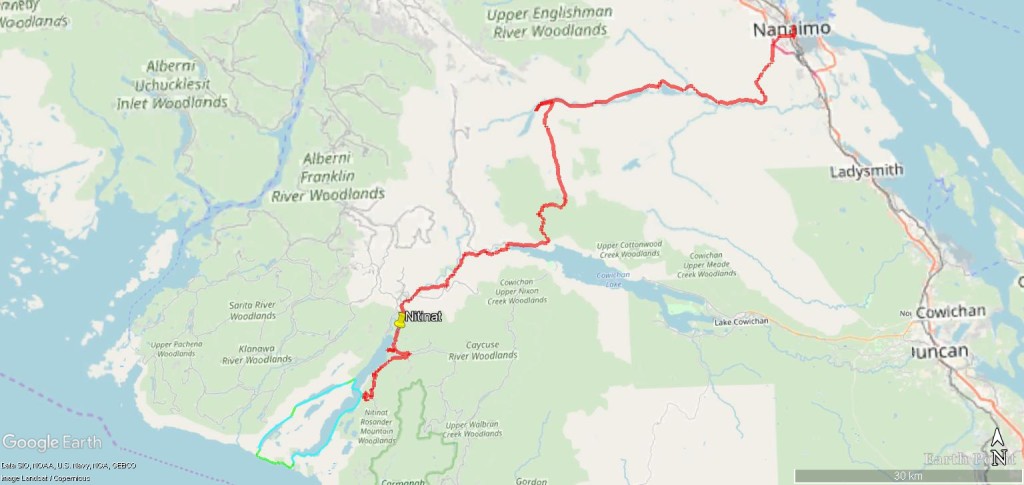
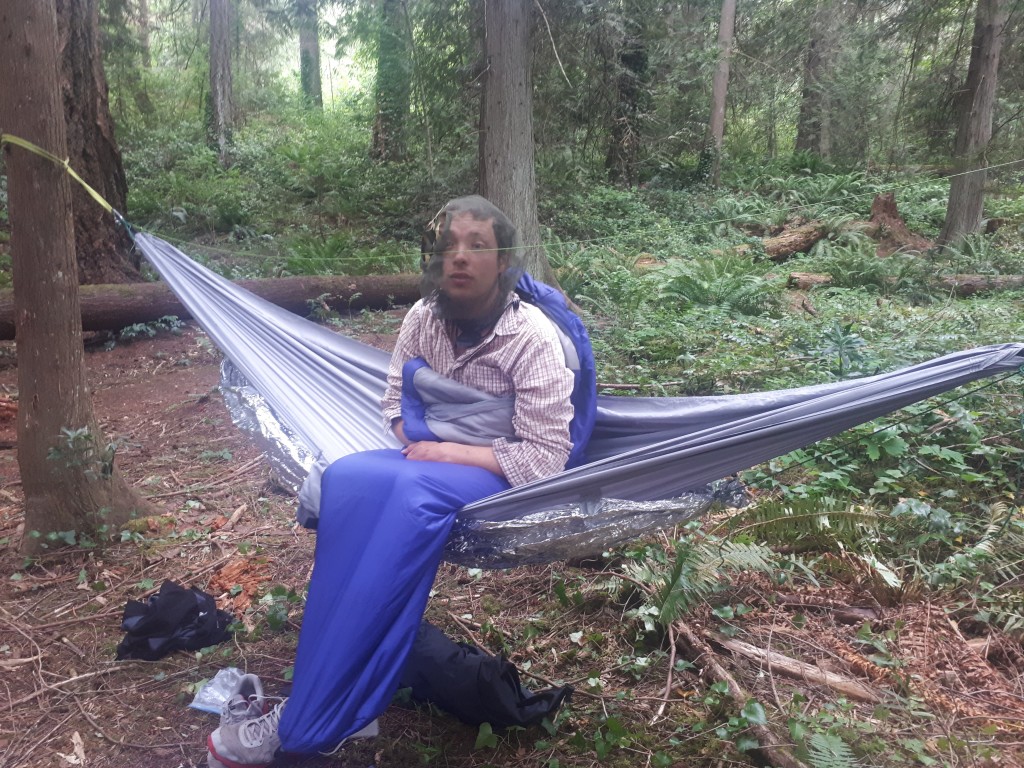
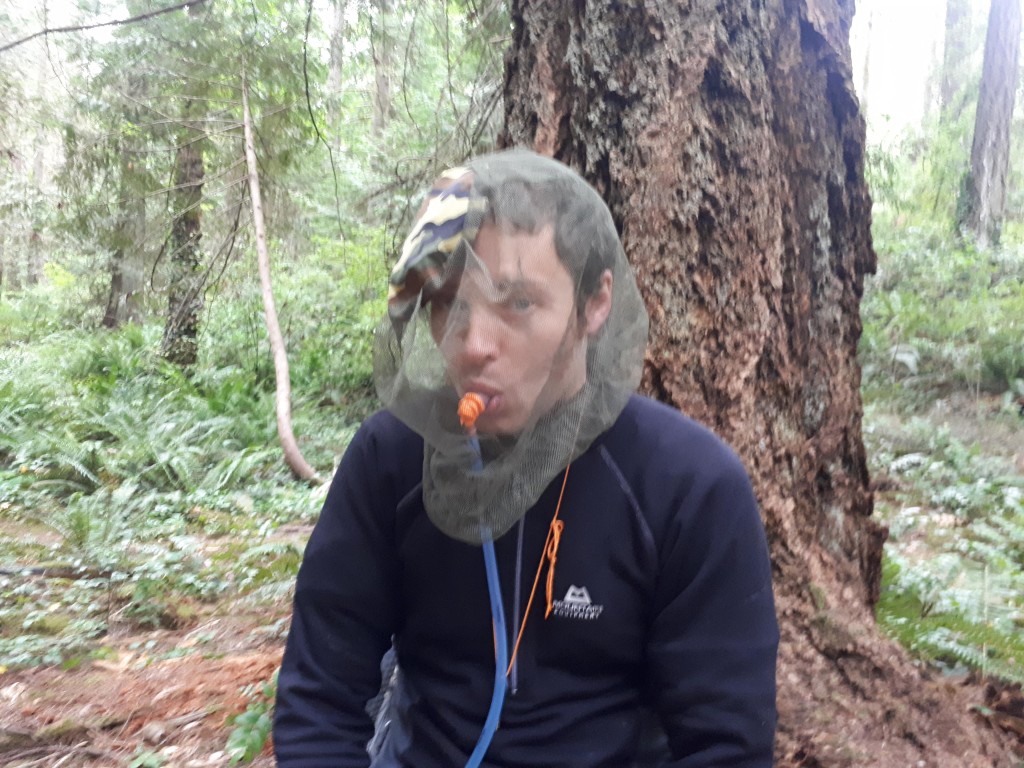
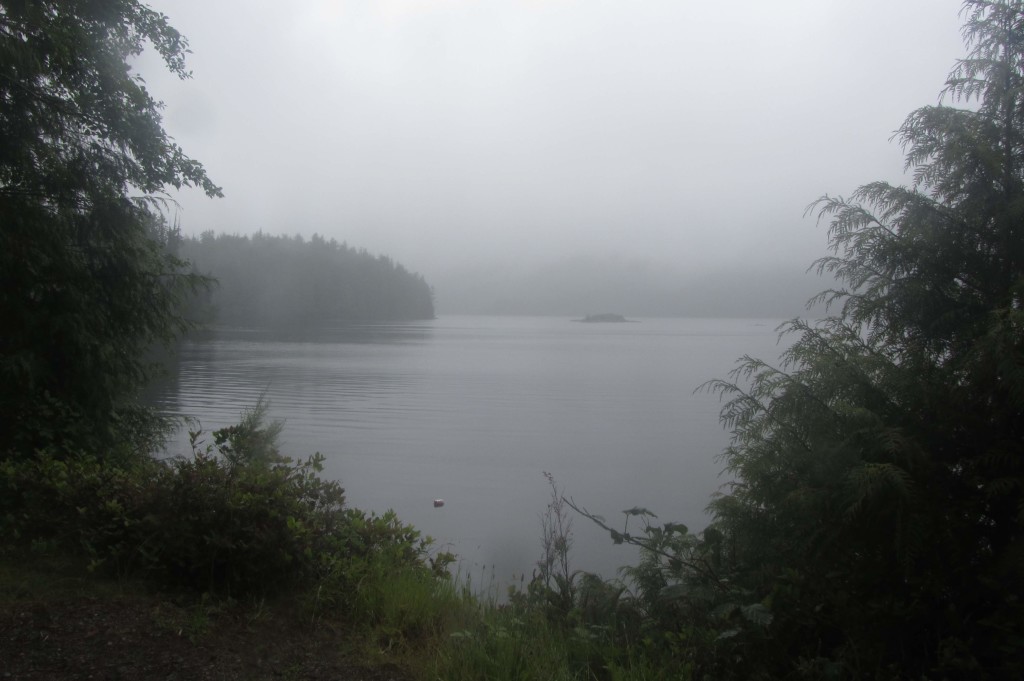
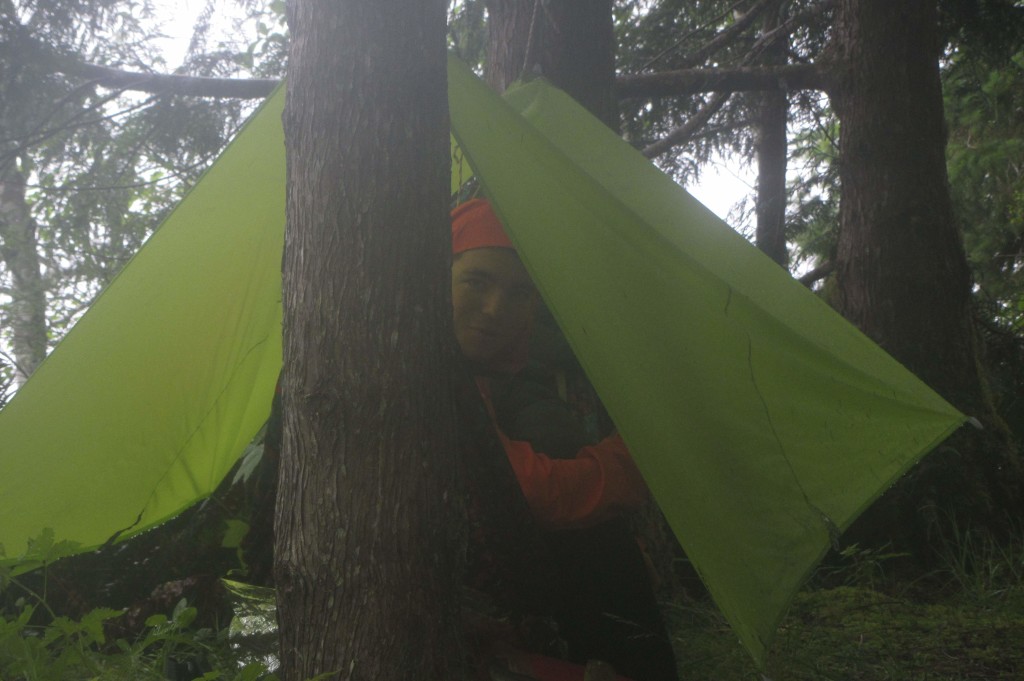
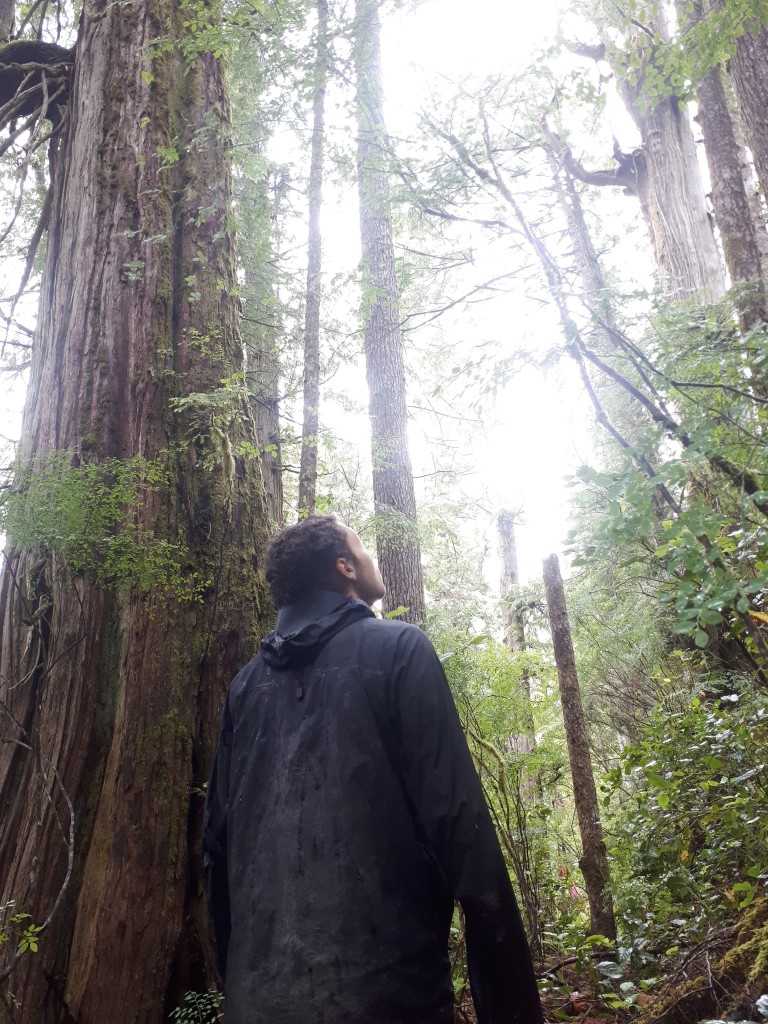
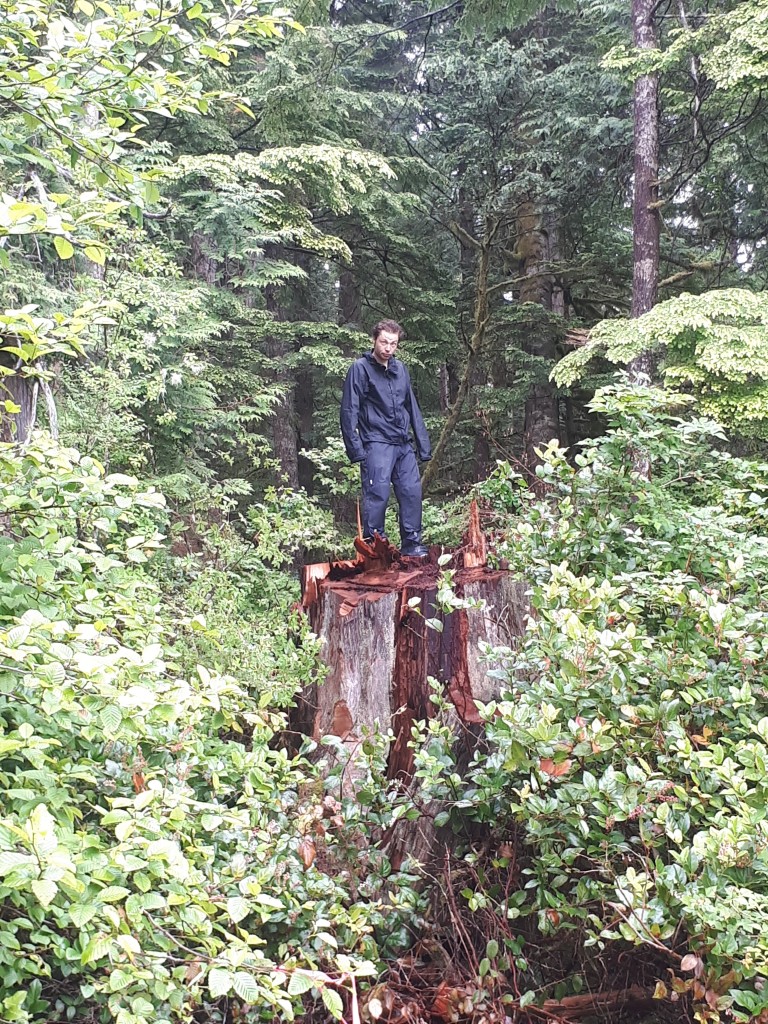
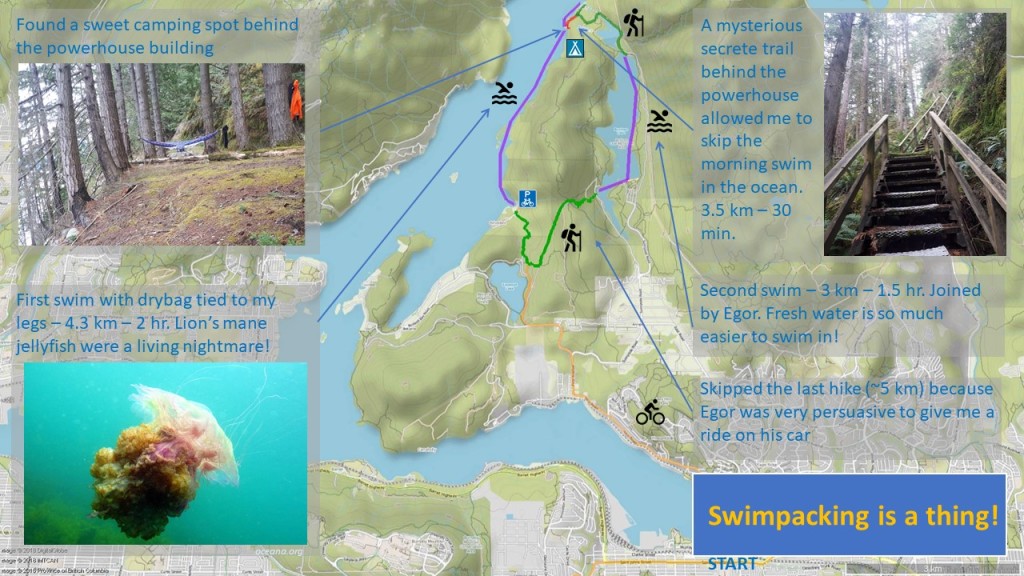
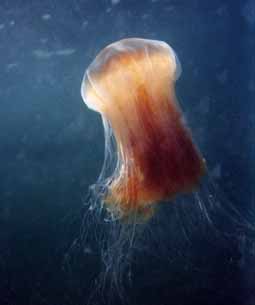
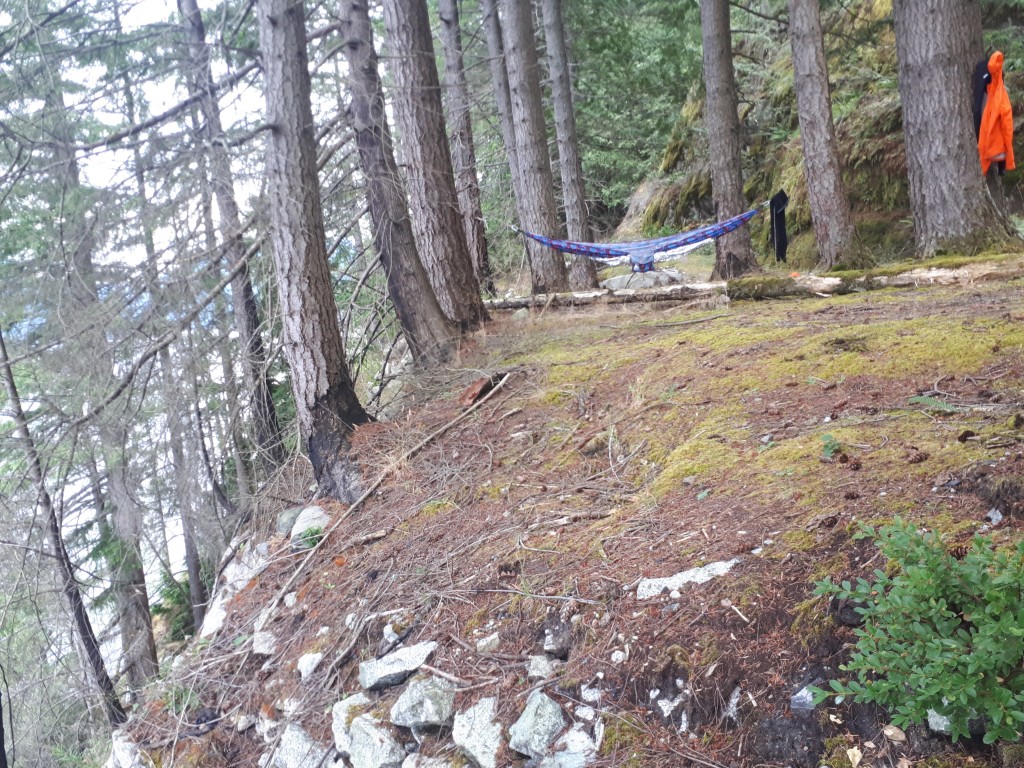
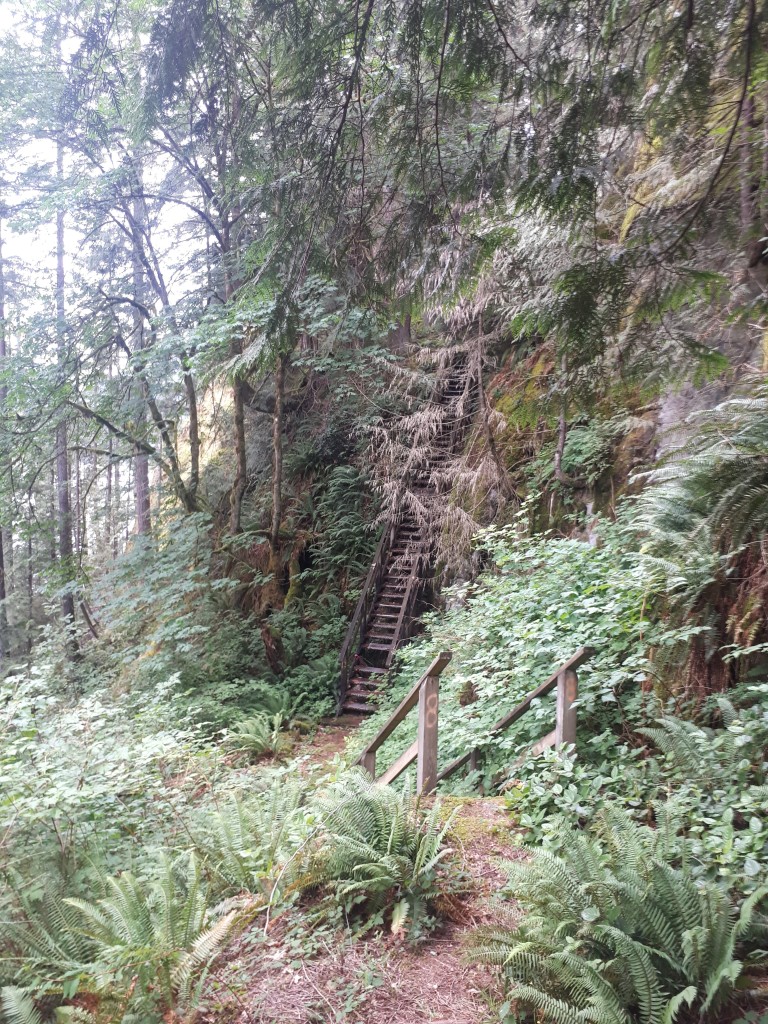
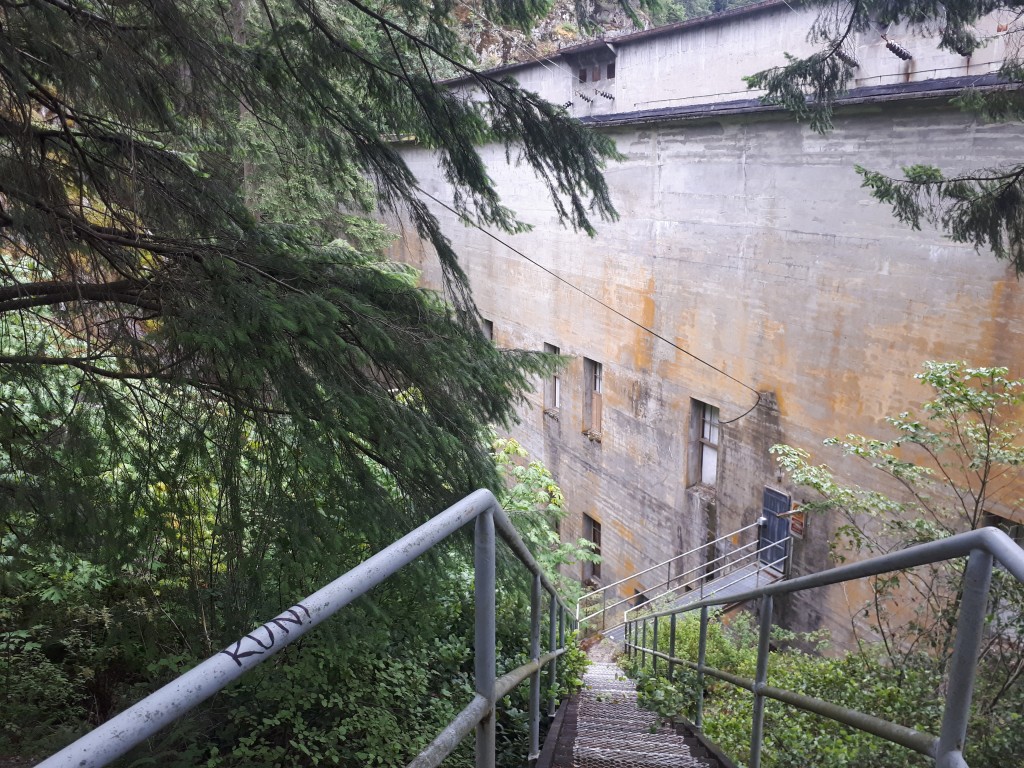
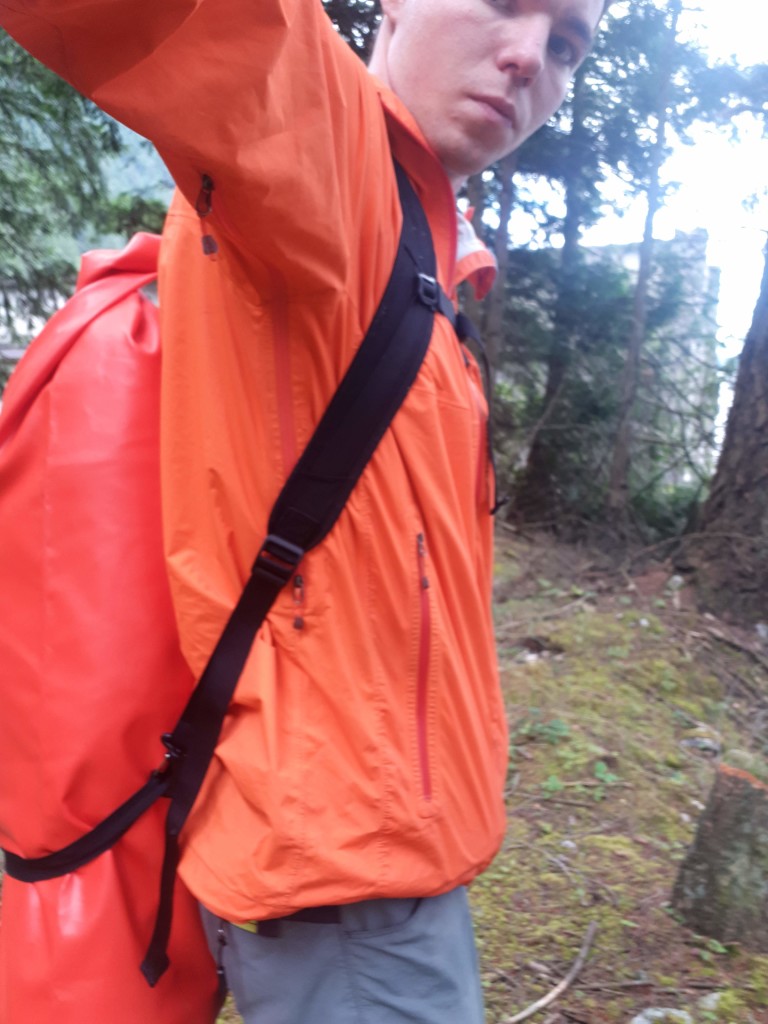

Wonderful trip report!! Made me laugh a lot. =)
Good for you for discovering/creating a new touring method. I think I will stick to biking, but that is because my swimming speed is probably less than 1 km/hr…